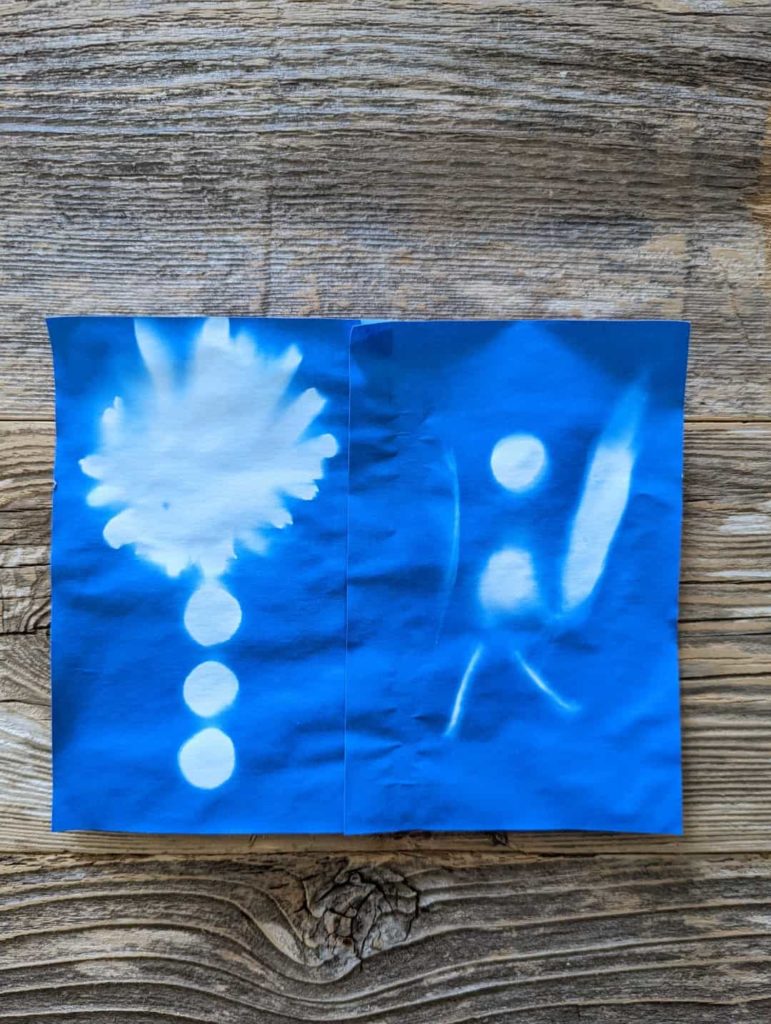Solar Printing Science Activity for Kids

In this solar printing activity, we’ll learn how the sun can cause chemical reactions. I love to blend science with another study–like art or history. If you’re planning a solar system study, a solar energy study, a study of UV light, a solar printing activity is a perfect pairing!
You’ll just need:
-
objects such as craft items like chenille sticks, foam or wood cut-outs, beads and treasures found on a nature hike- feathers, rocks, flowers, sticks–anything that might make an interesting design for your solar prints
-
sunlight
-
water – The solar print paper we used had instructions to rinse the designs in water AFTER being exposed to the sunlight to set the print and prevent it from fading over time.
-
towel
Creating Your Solar Prints
Follow the handling instructions on your solar print paper. Be sure you keep it out of bright light until the design is laid out on the paper you are ready to take them outside to make your solar prints.
I like using these foil pans from the dollar store for projects like this. These pans made it easy to transport the sun print paper when moving outdoors into the sun.
If you want to create larger solar prints, flip two or more pieces of the solar print paper over and tape them together on the backside. Carefully flip and use the larger canvas to make solar prints.
Place the objects on a a piece of the solar prints paper, and then place the paper in sunlight for 1-2 minutes.
The solar printing is finished when the exposed areas of the paper turn white. (The area under your objects should still be blue, since the sun didn’t hit there.) Take the paper out of the sunlight and remove the objects. Run water over the paper for a couple minutes. Then, lay the wet paper on a towel to dry.
Related post: Solar Magnification Experiment


How Solar Printing Works
Solar Print Paper produces prints by a process called cyanotyping. Cyanotyping involves treating paper with a solution of potassium ferricyanide and ferric ammonium citrate. The solar printing paper you buy has already been treated.
When the treated paper is exposed to sunlight, the sunlight reacts with the iron on the paper. This starts a chain reaction which causes ferric ferrocyanide, or the pigment Prussian Blue, to form.
Rinsing the paper washes the un-reacted iron away. As the paper dries, the Prussian blue color is revealed.
Try Solar Printing Yourself
Many school supply stores and art supply stores have solar printing paper. I bought ours at a local museum gift shop. Like with anything else, you can also find solar print paper on Amazon, too.
Get creative with objects. In the picture above, we used flowers and leaves from our yard in one print and sunscreen in the other.

More Summer Science Activities
Lesson and printable about the Sun and solar energy
Building A Square Foot Garden is a great all-summer science project for the entire family.
Make a fractal suncatcher.
Solar Magnification Experiment
For a summer full of fun science ideas, check out 100 Summer Science Activities.
Summer nights are perfect for stargazing. Learn the summer constellations.
I hold a master’s degree in child development and early education and am working on a post-baccalaureate in biology. I spent 15 years working for a biotechnology company developing IT systems in DNA testing laboratories across the US. I taught K4 in a private school, homeschooled my children, and have taught on the mission field in southern Asia. For 4 years, I served on our state’s FIRST Lego League tournament Board and served as the Judging Director. I own thehomeschoolscientist and also write a regular science column for Homeschooling Today Magazine. You’ll also find my writings on the CTCMath blog. Through this site, I have authored over 50 math and science resources.


